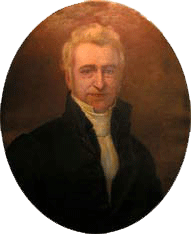Eliphalet Nott
(1773-1866)
Eliphalet Nott was born on June 25, 1773 on a farm in Ashford, Connecticut. At the age of 21, he received an MA degree from Rhode Island College (later Brown University) He was licensed to preach in 1796 and became pastor of the Presbyterian church in Cherry Valley, NY, and principal of its academy. John Blair Smith, then president of Union College, befriended Nott and encouraged him to consider pastorship at the First Presbyterian Church of Albany. In 1798, while still only 25, Nott accepted the invitation and moved his family to Albany. In 1800 Nott became a trustee of Union and in 1804 became its fourth president.
 |
|
Nott augmented the classical curriculum of Union College with an alternative course of study in science, a radical idea at the time. The new option emphasized mathematics, natural history, and physical science. From 1829 to 1845, concurrent with his position at Union, Nott also served as president of the Rensselaer Institute of Troy (later Rensselaer Polytechnic Institute). The position carried a salary of one dollar a year, but could be augmented with certain fees.
Though not formally trained in science or engineering, Nott began designing more efficient heating stoves. As an inventor, he acquired thirty patents for his contributions to the heating industry. One was called the "Nott stove," and he established H. Nott and Co. to manufacture it. Some of the profits from the sale of its stoves was donated to the College through the Nott Trust Fund.
After 62 years as president, Nott died on January 29, 1866. The architectural centerpiece of Union College, the tall round building planned by Ramee, was beautifully restored in the 1990s by the then-current President Roger Hull. Most fittingly, it is called the "Nott Memorial." The street that bounds the College's northern boundary is named for Nott, and a wide boulevard emanating from the college's main gate is named Nott Terrace.
Nott's innovations:
Kitchen ranges, cooking stoves wood and coal fired
Anthracite coal stoves - general design and components
Coal powered boilers
Stove and furnace exhaust pipe design
Related Topics:
Mechanical Engineering
Field of Heat Transfer (Nancy Fitzroy)
Article by M.Whelan and Dr. Edwin Reilly Jr.
Sources:
US Patent Office
Schenectady Historical Society
If you are a historian and wish to correct facts or publish a commentary or embedded article feel free to contact us.
Photos:: Permission and fees are required for use of photos in printed or internet publications.
Educational Use:: Students and teachers may use photos and videos at school. Graphics and photos must retain the Edison Tech Center watermark or captions and remain unmanipulated except for sizing.
Videos:: DVDs are available for personal/educational use. Republication of any part or whole of any ETC video requires a professional license agreement. Contact us for legal permissions and fees.

